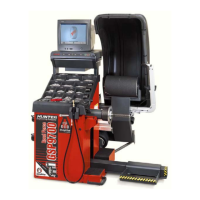GSP9700 Series Road Force Measurement System Operation 2. Balancing Overview 17
Modern “dynamic” balancers spin the wheel in order to measure both the up and
down imbalance force and the wobble or shimmy related imbalance (side-to-side).
Dynamic balancers direct the operator to place correction weights on the inside and
outside correction locations of the rim so that both imbalance shake (static) and
imbalance wobble (couple) will be eliminated.
SmartWeight may also utilize a single weight placement to balance out shake and
shimmy forces.
Static and Dynamic Imbalance Sensitivity
As a general rule of thumb, to achieve the best balance on an average sized tire and
wheel (15x6) assembly.
Residual static imbalance should be less than 1/4 ounce.
Residual couple imbalance should be less than 3/4 ounce.
Residual couple imbalance is preferred over remaining static imbalance.
It takes much more residual couple imbalance to cause a vibration than the same
amount of static imbalance.
The larger the diameter used for weight placement, the smaller the amount of
correction weight is required.
The wider the distance between the two weight placement locations, the smaller the
amount of correction weight is required.
If static balance is the only option, always verify that the remaining couple residual
imbalance is within acceptable tolerance.
For detailed information on adjustment and setup of modes of wheel balancing
sensitivity see section 5.1 and section 6.4.

